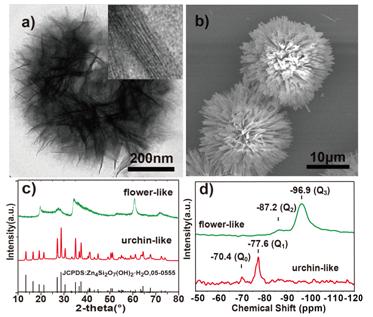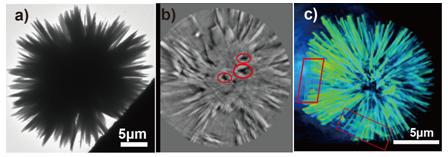| New hierarchical zinc silicate nanostructures and their application in lead ion adsorption |
| From: PublishDate:2013-06-15 Hits: |
Hierarchical structured porous materials, which combine nanoparticles’ high chemical activity and microscale structures’ physical stability, are appealing materials as adsorbents in water treatment, energy storage and catalyst applications. However, it’s difficult to make clear the assembled structure through real time three dimensional imaging. A team from Key Laboratory for Molecular Nanostructures and Nanotechnology, Institute of Chemistry, Chinese Academy of Sciences has gained insight into the structures and assembled mechanisms of hierarchical structured zinc silicates. Their research has been published on volume 22, 2012 in Journal of Materials Chemistry. They reported the morphology and crystallographic information of two new hierarchical zinc silicate nanomaterials: flower-like and urchin-like zinc silicates (Figure 1a and b). XRD and solid state 29Si NMR spectra of these two materials suggested them to have different crystal structures (Figure 1c and d). HRTEM images showed that the nearly amorphous flower-like zinc silicates’ secondary nanopetals had a layered structure (Figure 1a, insert), unlike these flower-like metal oxide nanostructures whose nanopetals were composed of aggregated nanoparticles.
Figure 1. a) TEM image of the flower-like zinc silicate (insert: HRTEM image); b) SEM image of the urchin-like zinc silicate;XRD patterns c) and NMR 29Si d) of the two. The TEM image of the urchin-like sample showed only a black shadow (Figure 2a). Because the sample was too thick for the transmission of the TEM electron beam, internal structure was hard to observe using TEM, making it difficult to understand the growth mechanism of the materials. For a better illustration of the internal structure of the material, a three dimensional imaging of the material was obtained by X-ray nanotomography (Nano CT), which has a spatial resolution of 30 nm using an 8 keV monochromatic synchrotron beam in BSRF. Such spatial resolution is suited for this urchin-like structure.As shown in Figure 2b and c, almost all microrods were assembled in order to point from the center to the outer surface with a porous core. Three dimensional images showed new structural details not detectable with other techniques. Though most microrods were aligned in a radial manner nicely, some dangling misaligned microrods could be observed inside the regular microrod array (red square in Figure 2c). These dangling rods may be broken from the assembly, or they were latecomers that could not be fit into the assembly. Such defects during the assembly became visible with the synchrotron based X-ray nanotomography.
Figure 2. a) TEM image, b) reconstructed slice image and c) reconstructed three dimensional rendering view of the urchin-like zinc silicate. Such structural information has never been offered by other techniques, and the work provided the scientific community clues to understand the growth mechanism. Synchrotron sources have helped the team to unveil the complex hierarchical structure. Used as adsorbents for lead ions from water, urchin-like zinc silicate showed much high adsorption capacity per unit of the surface area. However, more complex nanomaterials are to be characterized owing to the relationship between the structure and property; and much higher spatial resolution would be useful for investigating new functional materials.
Article: Jin Qu, Chang-Yan Cao, You-Li Hong, Chao-Qiu Chen, Pei-Ping Zhu, Wei-Guo Song* and Zi-Yu Wu*. New hierarchical zinc silicate nanostructures and their application in lead ion adsorption. J. Mater. Chem., 22, 3562, 2012. |
|
|
| Chinese
Science Highlights
Home /
Copyright © 2011 - 2012 Beijing Synchrotron Radiation Facility



